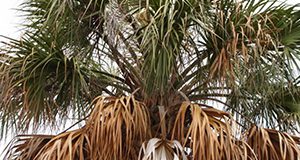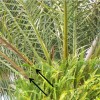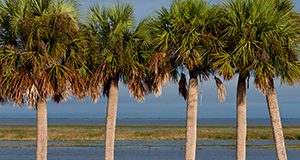Lethal bronzing disease (LBD), formerly Texas Phoenix Palm Decline (TPPD), is a lethal phytoplasma infection of various palm species in the state of Florida. It was first detected in Florida in 2006 and has since spread to 31 different counties and been isolated from 16 different species of palm. This three-page fact sheet describes the pathogen and hosts of LBD, its symptoms, how to diagnose it, and disease management practices. Written by Brian W. Bahder and Ericka Helmick and published by the UF/IFAS Plant Pathology Department, this article is a revision of an earlier fact sheet by Nigel A. Harrison and Monica L. Elliott.
https://edis.ifas.ufl.edu/pp163
Tag: Palm Diseases
Sampling Palms for Lethal Yellowing and Texas Phoenix Palm Decline Phytoplasmas
In Florida, palms are an economically important group of trees in the nursery and landscaping industries. Phytoplasma diseases of palms are a major concern because they infect a wide variety of these valuable ornamental palms, and they are lethal. Once symptoms appear, trees begin to decline, frequently rapidly, and can die in as few as 3 to 5 months. This 4-page fact sheet written by Brian W. Bahder and Ericka E. Helmick and published by the UF/IFAS Department of Entomology and Nematology describes how to sample palms for disease and how to submit samples to the Vector Entomology Lab. Includes a table listing equipment and supplies and protocol for sampling palm trunk tissue.
http://edis.ifas.ufl.edu/in1197
Texas Phoenix Palm Decline

Texas Phoenix palm decline is a new disease in Florida, caused by an unculturable bacterium. It is a fatal, systemic disease that kills palms relatively quickly. This six-page fact sheet explains the pathogen and hosts of TPPD, its symptoms, how to diagnose it, and provides disease management practices. Written by Nigel A. Harrison and Monica L. Elliott and published by the Plant Pathology Department.
http://edis.ifas.ufl.edu/pp163
Calonectria (Cylindrocladium) Leaf Spot of Palm (PP302)
 Calonectria is a fungus that affects a large number of hosts worldwide, including timber and ornamental, agricultural, and horticultural crops, causing a wide range of disease symptoms, such as cutting rot, damping-off of seedlings, leaf spot, shoot blight, and root rot. This 4-page fact sheet was written by Jiaming Yu and Monica L. Elliott, and published by the UF Department of Plant Pathology, January 2013.
Calonectria is a fungus that affects a large number of hosts worldwide, including timber and ornamental, agricultural, and horticultural crops, causing a wide range of disease symptoms, such as cutting rot, damping-off of seedlings, leaf spot, shoot blight, and root rot. This 4-page fact sheet was written by Jiaming Yu and Monica L. Elliott, and published by the UF Department of Plant Pathology, January 2013.
http://edis.ifas.ufl.edu/pp302
Fusarium Wilt of Canary Island Date Palm (PP215/PP139)
 As the name implies, Fusarium wilt of Canary Island date palm is primarily observed on the Canary Island date palm. It was first documented in the United States in the 1970s in California, but it was not documented in Florida until 1994. It now occurs throughout the state. The fungus obstructs the xylem (water-conducting) tissue, which results in desiccation and death. This 5-page fact sheet was written by Monica L. Elliott, and published by the UF Department of Plant Pathology, July 2012.
As the name implies, Fusarium wilt of Canary Island date palm is primarily observed on the Canary Island date palm. It was first documented in the United States in the 1970s in California, but it was not documented in Florida until 1994. It now occurs throughout the state. The fungus obstructs the xylem (water-conducting) tissue, which results in desiccation and death. This 5-page fact sheet was written by Monica L. Elliott, and published by the UF Department of Plant Pathology, July 2012.
http://edis.ifas.ufl.edu/pp139
Bud Rot of Palm (PP220/PP144)
 To understand bud rots, an explanation of palm anatomy is necessary. The growing point of the palm is often called the bud or heart. All leaves originate from there, and each palm stem has only one. Thus, when the bud is damaged or diseased, the palm usually dies. The first symptom is discoloration and wilting of the spear leaf and wilting/discoloration of the next youngest leaf. This 4-page fact sheet was written by Monica L. Elliott, and published by the UF Department of Plant Pathology, July 2012.
To understand bud rots, an explanation of palm anatomy is necessary. The growing point of the palm is often called the bud or heart. All leaves originate from there, and each palm stem has only one. Thus, when the bud is damaged or diseased, the palm usually dies. The first symptom is discoloration and wilting of the spear leaf and wilting/discoloration of the next youngest leaf. This 4-page fact sheet was written by Monica L. Elliott, and published by the UF Department of Plant Pathology, July 2012.
http://edis.ifas.ufl.edu/pp144
PP278 Fusarium Wilt of Queen Palm and Mexican Fan Palm
PP278, a 6-page illustrated fact sheet by Monica L. Elliot, describes this lethal fungal disease affecting primarily queen and Mexican fan palms — pathogen and hosts, symptoms, diagnosis, and disease management. Includes references. Published by the UF Department of Plant Pathology, June 2010.
http://edis.ifas.ufl.edu/pp278
PP-243/PP163 Texas Phoenix Palm Decline
Revised! PP-243, a 5-page illustrated fact-sheet by Nigel A. Harrison and Monica L. Elliott, describes this new systemic disease affecting primarily date palms in Florida, the pathogen and hosts, symptoms, diagnostics, and disease management. Includes references. Published by UF Department of Plant Pathology, February 2009.
http://edis.ifas.ufl.edu/PP163

